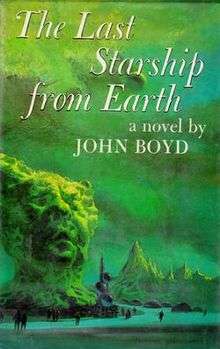The Last Starship from Earth
The Last Starship from Earth is a 1968 science fiction novel by John Boyd, and is his best known novel.
 | |
| Author | John Boyd |
|---|---|
| Cover artist | Paul Lehr |
| Country | United States |
| Language | English |
| Genre | Science fiction |
| Publisher | Weybright & Talley, New York |
Publication date | 1968 |
| Media type | Print (Hardcover & Paperback) |
Plot summary
The novel is set in a dystopian society in the very near future. Although it is not obvious at first, this is also an alternate history story.
The central character is Haldane IV, a mathematician, in a caste-based society. He forms a forbidden relationship with Helix, a poet. He also becomes interested in investigating Fairweather, a famous mathematician who lived shortly before his time, and his son Fairweather II, whom he discovers led a rebellion, which was defeated. Eventually he is given a show trial and deported to another planet, where he meets Fairweather II.
In this world, Jesus Christ became a revolutionary agitator and was never subjected to crucifixion. He assembled an army to overthrow the Roman Empire, and established a theocracy that has lasted until the twentieth century. He was killed by a crossbow while entering Rome, so the crossbow becomes a religious symbol similar to the cross in our time-line.
Trilogy
The book is supposedly the first in a trilogy. The other books appear to be The Pollinators of Eden, and The Rakehells of Heaven.
Critical response
Robert A. Heinlein said, "It belongs on the same shelf with 1984 and Brave New World," and the Los Angeles Times noted, "In the literate tradition of Huxley, Orwell, and Bradbury, it is a work of extraordinary impact." Joanna Russ, in her review of the book in 1969, was highly critical and wrote, "I forgive Mr. Boyd the anguish his novel caused me and hope he will eventually forgive me the anguish this review may cause him, but for Berkley there is no forgiveness. Only reform. Don't do it again."[1]
Spider Robinson, however, praised the novel as "delightful, with a rigorously consistent internal logic that doesn't really become apparent until the very last chapter."[2]
References
- Fox, Margalit (7 May 2011). "Joanna Russ, 74, Dies; Wrote Science Fiction". The New York Times.
- "Galaxy Bookshelf", Galaxy Science Fiction, December 1976, p.128
- Clareson, Thomas D. (1971). SF: the other side of realism: essays on modern fantasy and science fiction. Bowling Green University Popular Press. p. 186.
- Dannenberg, Hilary P. (2008). Coincidence and counterfactuality: plotting time and space in narrative fiction. Frontiers of narrative. U. of Nebraska Press. p. 206. ISBN 0-8032-1093-0.